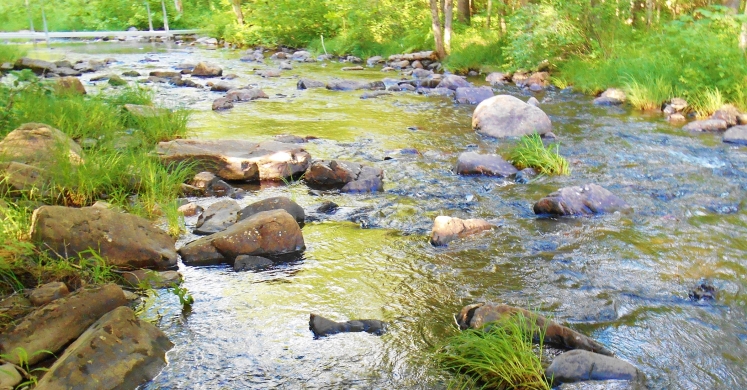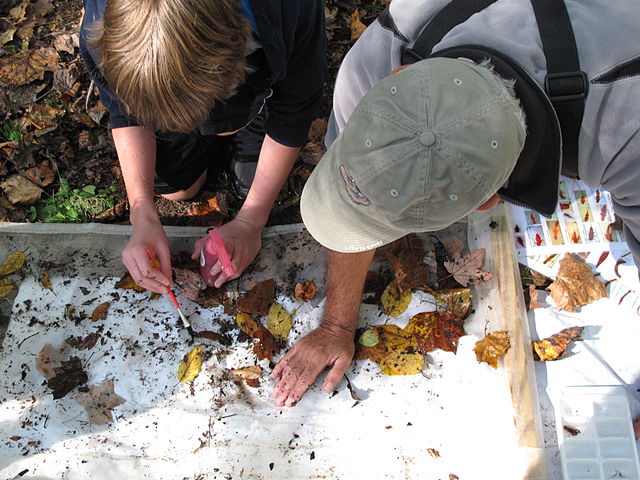Blog

#bioPGH Blog: Conduct Your Own Stream Assessment
 A resource of Biophilia: Pittsburgh, #bioPGH is a weekly blog and social media series that aims to encourage both children and adults to reconnect with nature and enjoy what each of our distinctive seasons has to offer.
A resource of Biophilia: Pittsburgh, #bioPGH is a weekly blog and social media series that aims to encourage both children and adults to reconnect with nature and enjoy what each of our distinctive seasons has to offer.
“In all the things of nature, there is something of the marvelous.” -Aristotle
Living in a city of three rivers, we are sometimes oddly disconnected from our waters and the life within them. Every living thing on Earth needs water, and our waterways are incredibly complex communities bursting with little creatures and non-living features that all make up components of a healthy stream. This week, if you’re up for a learning adventure, try conducting an assessment of a local stream near you. It will be a great way to explore how complex even the smallest creeks and streams really are. We will start small and just look at four facets of stream biology: water temperature, water cloudiness, streambed, and macroinvertebrates. All of the activities below are suitable for the whole family, so try these out together!
Supplies:
-Notebook and pencil to record observations
-Temperature: Meat or grilling thermometer
-Turbidity: Bucket and water glass
-Leaf pack: Organic cotton mesh bag, flagging tape, rope, cake pan
First things first, I do want to mention the most important part of this: permits and permission. No matter what stream you’re exploring, always be sure to get permission first—whether it’s a park or private property. If you plan to set up a leaf pack (discussed below), you will definitely need to alert whomever is responsible for the area. Also, the leaf packs do require a Pennsylvania fishing license. Collecting aquatic macroinvertebrates (even for educational purposes, and even if you plan to release them) counts as catching “fishbait,” which requires a fishing license. Other than that—have fun exploring!
Water Temperature There are no rules for what temperature a stream’s water “should be,” but temperature plays a huge rule in what species will be found in a given stream. All living things have a preferred temperature range, and can’t survive in temperatures that are too extreme in either direction. Temperature also affects water chemistry. Oxygen and other gases dissolve more readily into cold water than warm, but alternatively, some minerals and other particles dissolve more readily in warmer water than in cold. Water that is too warm can also grow algae too quickly, which can harm fish or macroinvertebrates in the water. To measure water temperature, you can easily use a meat thermometer from the kitchen; then you can compare it to the USGS gauge nearest you.
Turbidity This is a measurement of how clear or cloudy the water is. The cloudiness comes from particles suspended in the water, and these particles can come from such things as storm runoff, pollution, or stream bank erosion. High turbidity (very cloudy water) is particularly problematic for the creatures living in the stream because it leads to less oxygen dissolved in the water; thus it is an important measurement! The equipment to measure turbidity can be specialized, but if you are just keeping track of your own stream out of pure curiosity, you can create your own scale (like below) and compare a sample of your stream water to it. To do this, use a bucket to collect a sample of water from the stream (be sure not to stand upstream of where you’re collecting the water!) Carry the bucket to a table or an area with soft grass, and collect a sample in a water glass. Hold the water glass to your scale and write down the number of the square that most closely resembles the color of the water. Be sure to keep track of turbidity on different days to see if it changes! For more information, check out what the USGS has to say about turbidity.

Streambed Substrate What kind of material is on the bottom of the stream? Is it large rocks or pebbles? Smaller particles like sand or silt? A good quality stream with high biodiversity tends to have more rocks and pebbles than sand and silt. For your own record-keeping, you can write a description of your streambed’s substrate, of if you would like to be more specific, you can conduct a Wolman pebble count.
Macroinvertebrate Community “Macroinvertebrates” is a collective term for the insects, mussels, worms, and crustaceans you might find in your stream. They make up the backbone of aquatic communities, and they are important indicators of water quality—healthy streams will have higher species diversity, and there are some species that can only survive in clean waters. You can do a fun macroinvertebrate survey by setting out a leaf pack in a stream, and waiting for some organisms to move in.
To create the leaf pack, you will first need either a bag specifically created for leaf pack work (there are many leaf packs kits available for purchase if you search online) or honestly—improvise. More than one wetland scientist has used kitchen strainers from a department store as macroinvertebrate exclusion tents! What you’re looking for is a mesh material with openings large enough for invertebrates to crawl inside (if you need to, you can cut little openings in the bag). Organic cotton reusable produce bags would be perfect, and be sure to do avoid synthetic materials like plastic in case the bag is lost in the stream. Once you have selected a bag, fill it with leaves until the bag is full but not jammed. Tie off the bag, and be sure to mark it! If you have flagging tape, you can label it with your name and email address in case someone finds it.
The next step is to secure the leaf pack to your desired location in the stream. You will need to anchor the bag to something, like a tree root or heavy rock. Ideally, the leaf pack will reach the water surface but will be neither completely floating nor completely submerged. Leave the pack in the water for 1-2 weeks—this is why permission is important.
When you want to identify what you have found, you can sift through the leaf pack contents in a large pan such as a sheet cake pan or large casserole pan, and be as gentle as you can to make sure all of your discoveries can be returned in good condition back to the stream. Use the key on page 8 of this DEP document to help you identify what you have found!

Photo: USFWS - Searching for macroinvertebrates
A one-time assessment can be fun and intriguing, but conducting this same assessment across seasons and years provides the most insight. If your family tries out this assessment and enjoys it, share some findings to social media with the hashtag #bioPGH or email me at mwheeler-dubas@phipps.conservatory.org.
Connecting to the Outdoors Tip: If your family really enjoys exploring, you can make these activities even more inquiry-based!
1.) Do you find more macroinvertebrates in still water or in water with a slight current?
2.) Do different leaf types attract different macroinvertebrates?
3.) Is the turbidity higher after a rainfall event?
4.) How does the water temperature change after a rainfall event?
5.) Where does this stream flow from here? Into another river? Where does that river flow? If there are pollutants in this stream, what does that mean for the waterways further down?
Continue the Conservation: Share your nature discoveries with our community by posting to Twitter and Instagram with hashtag #bioPGH, and R.S.V.P. to attend our next Biophilia: Pittsburgh meeting.
Resources
PA Natural Heritage Program: User’s Manual and Guide to the PA Aquatic Community Classification
Photo Credits: Daniel Absi (Pexels) CC0 and Laurie Gouley (Pexels) CC0

